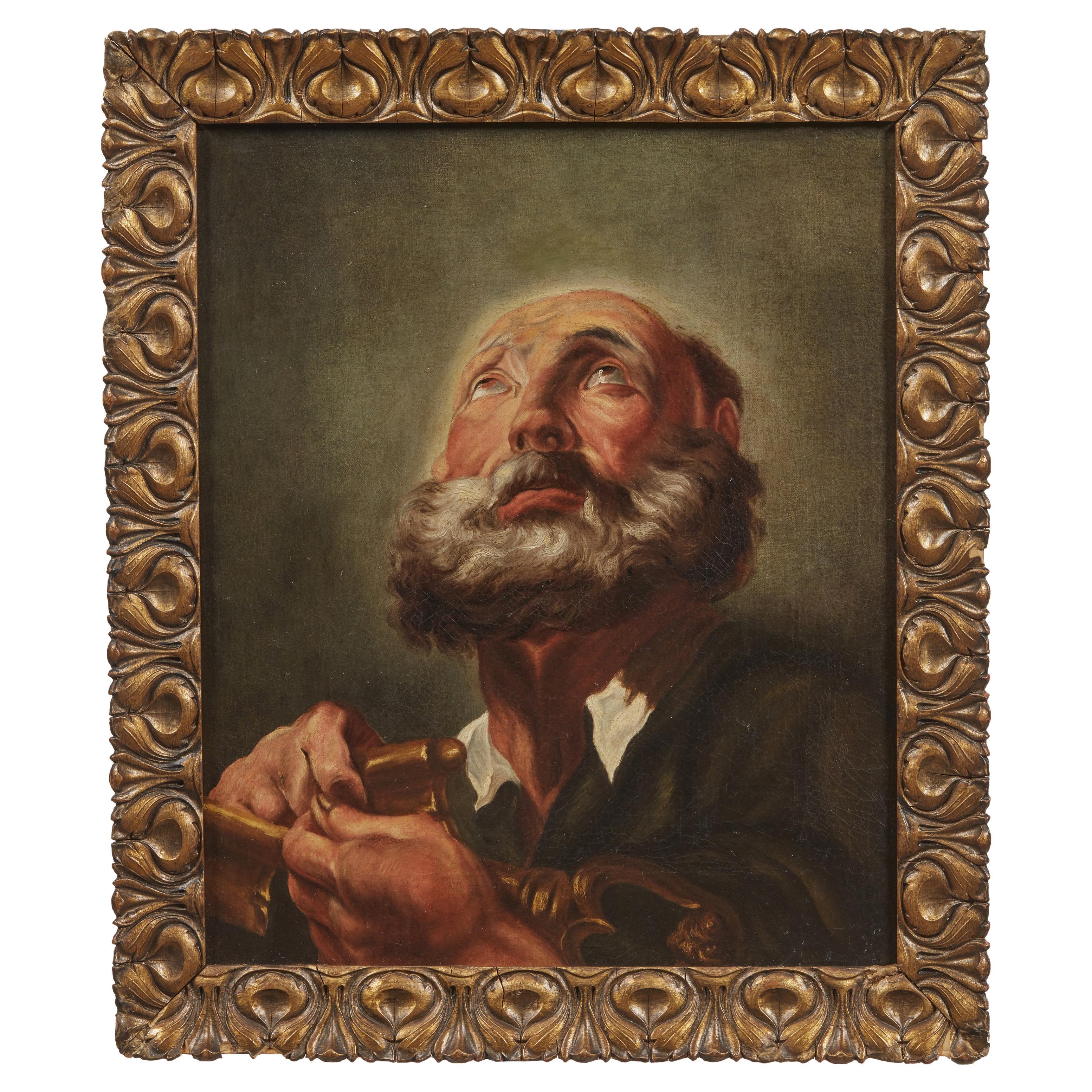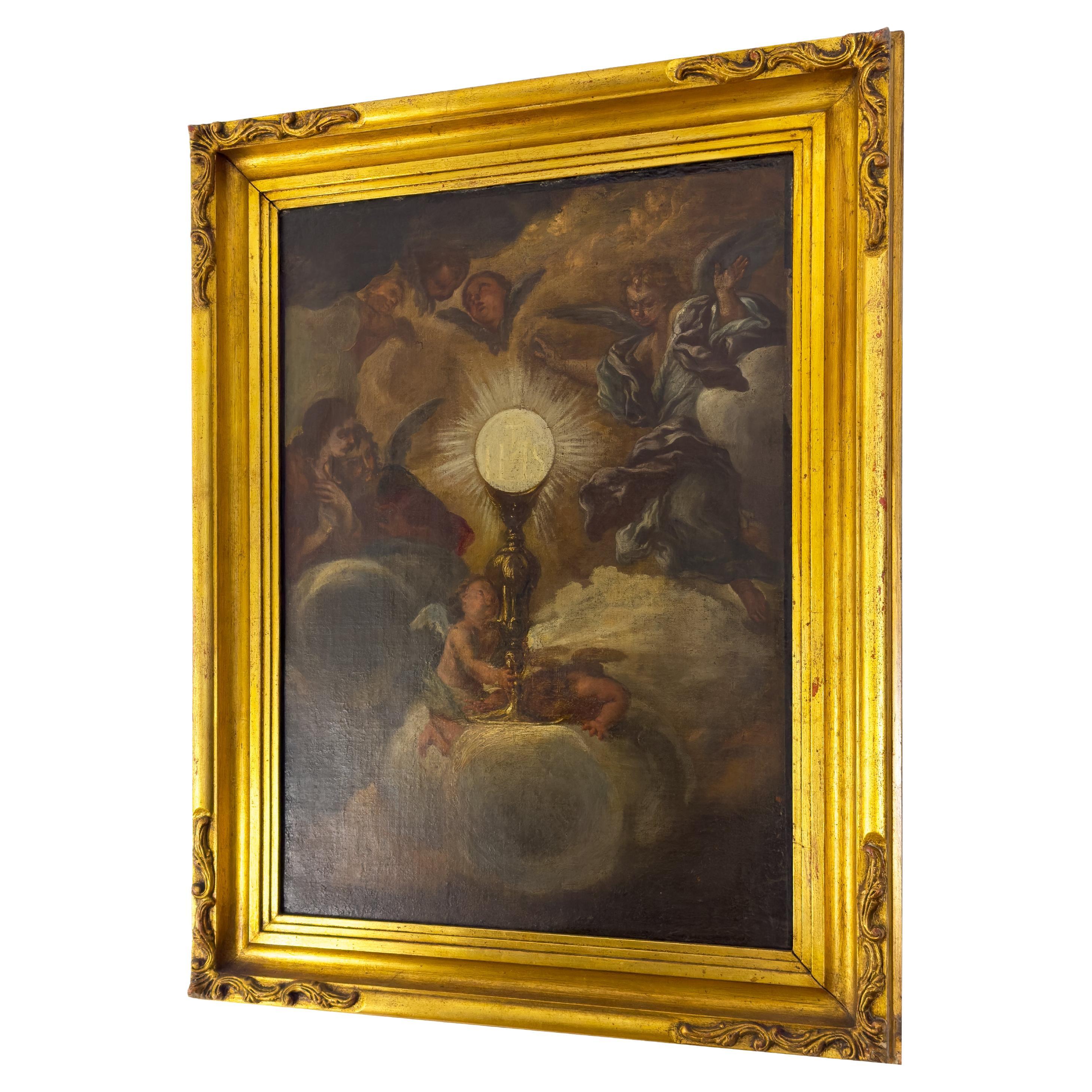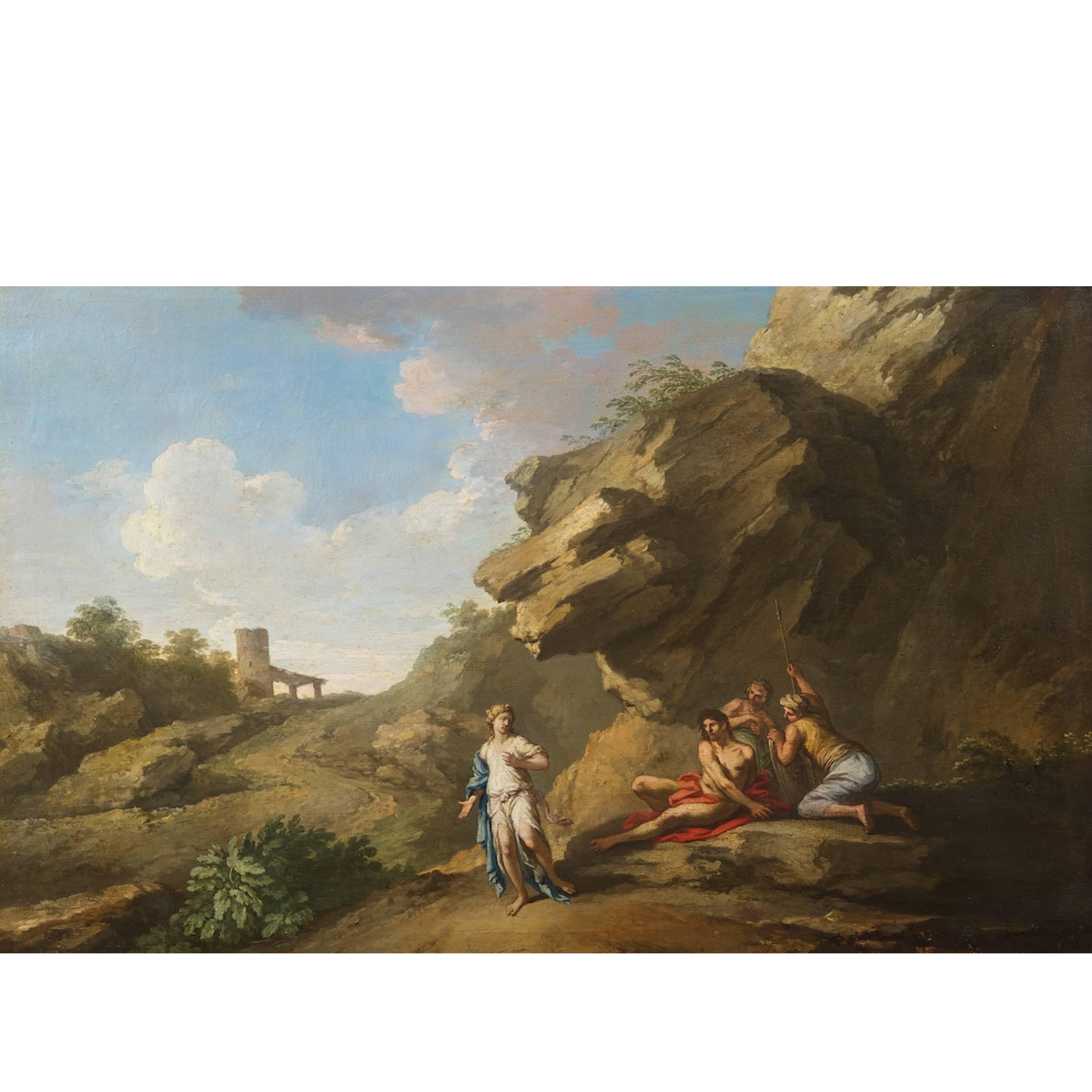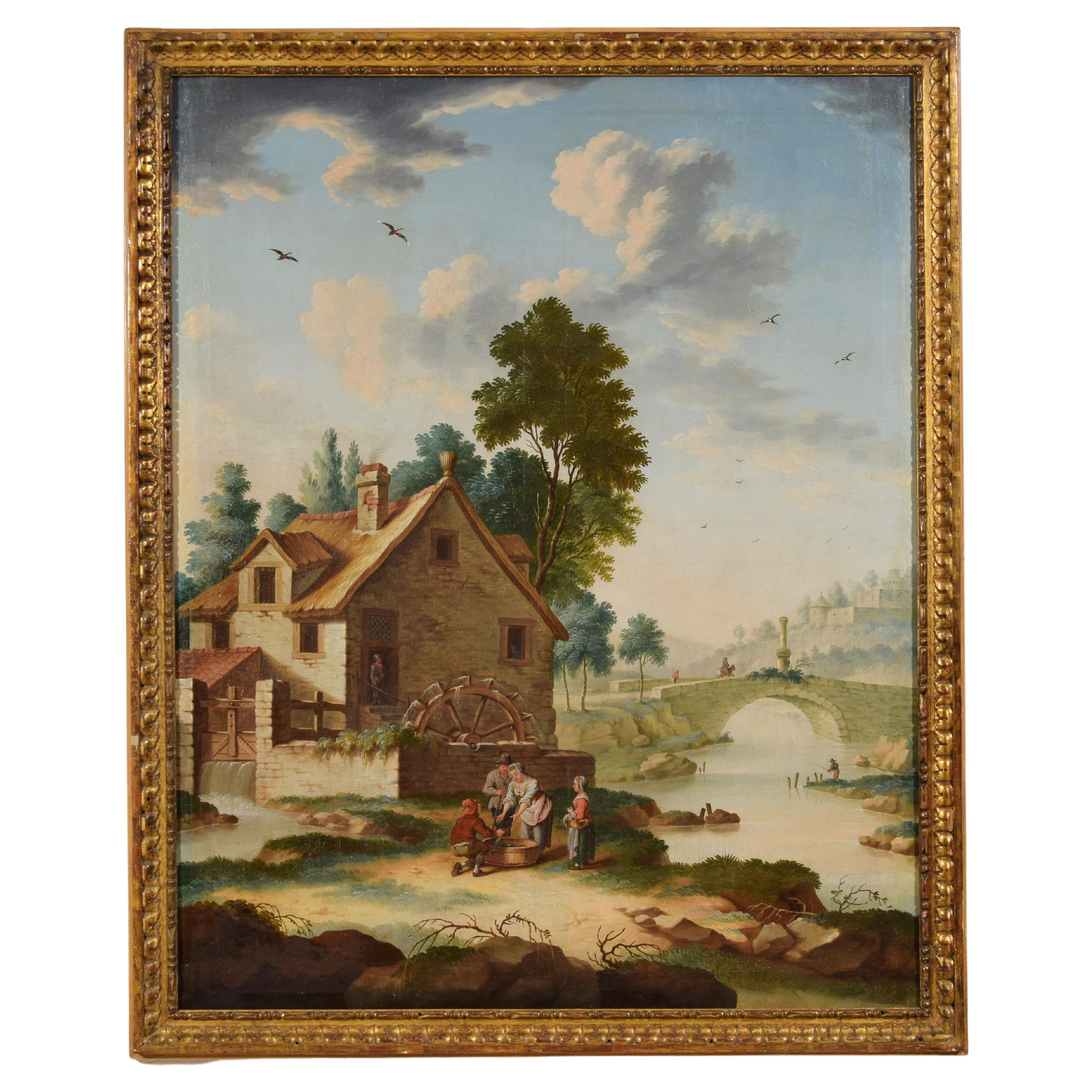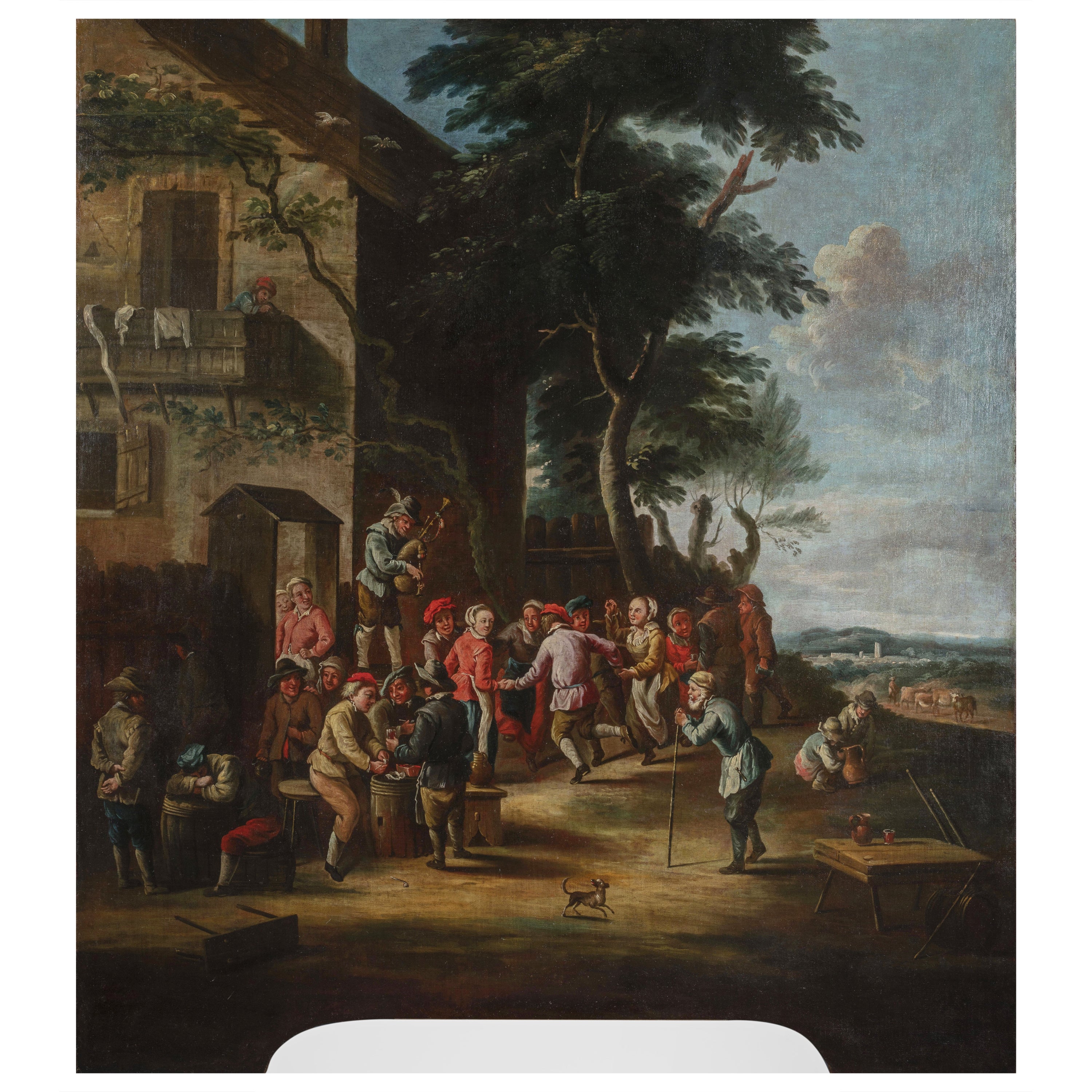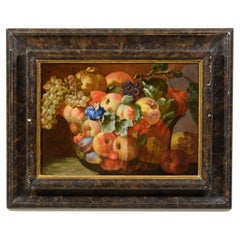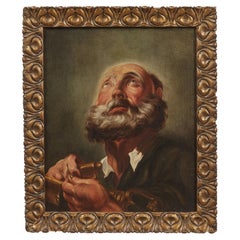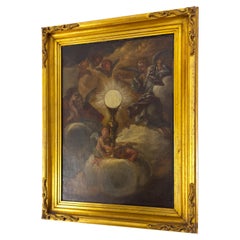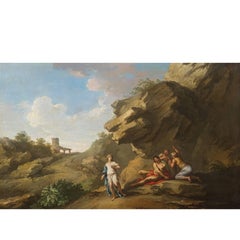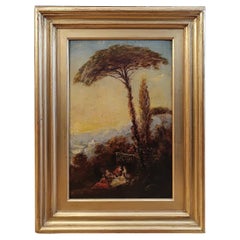Items Similar to 18th Centuy, Italian Painting with Landscape by Giovanni Battista Colomba
Want more images or videos?
Request additional images or videos from the seller
1 of 17
18th Centuy, Italian Painting with Landscape by Giovanni Battista Colomba
About the Item
Giovanni Battista Innocenzo Colomba (1713 – 1793)
Landscape with figures
Oil on canvas, Frame H 102 x L 112 x P 8; canvas H 77 x L 87
The valuable painting, attributable to the painter Giovanni Battista Innocenzo Colomba (1713 - 1793), depicts a wooded landscape animated by characters. At the center of the canvas is a bridge with two arches from which flow lively waterfalls, characteristic of the works of the painter. In addition to the bridge, built of bricks and crossed by some travelers with steeds, the landscape opens, hilly, and then be bordered by large mountains that clear away. A fortress shows a turreted castle overlooking the void. In the foreground, along a path, several people are caught and portrayed in their daily lives. From the left, a couple of travellers take a break, while a few others, accompanied by horses, continue their journey. In the middle two peasants, she with a wicker basket on her head full of wheat and a scythe in her hand, he sitting, with a stick and a pannier on his shoulders, entertain themselves in a dialogue, while on the right two humble parents pray before a child in need of care. The dramatic scene, full of pathos, exalted by the gestures of comfort and concern of two people who flock, are joined by a couple of friars through a gesture of blessing, reminiscent of the power of faith and hope. It is therefore a work of fine workmanship, very pleasant on the aesthetic level and certainly decorative. However, the landscape and the many characters depicted conceal a richer and more vigorous message of faith that the author develops with discretion and descriptive force. In the work is immediately recognizable the style that distinguishes the works of the mature painter, in which the lively and bright palette is accompanied by fine brushstrokes to form landscapes that oscillate between Rococo and Neoclassicism.
Giovanni Battista Innocenzo Colomba (1713 - 1793) was born in Arogno (Canton Ticino), in a family of painters, plasterers and architects whose founder is Andrea Colomba (1567-1627). He learned painting from his uncle, Luca Antonio Colomba, a painter at the Wüttemberg court in Germany, and around 1737 he was an independent painter in Mainz, where he painted several frescoes and decorations. It is probable that he completed his training at the Academy of Vienna, in those years a fundamental centre of aggregation and cultural exchange. He had an intense activity as a set designer and decorator at various princes. In 1741 in Frankfurt he decorated, with squares and allegorical paintings, the ceiling of Römer’s "Imperial Staircase" (destroyed in World War II), on the occasion of celebrations for the coronation as emperor of Charles VII (12 February 1742). In 1748 he was called to Hamburg where he worked in Schleswig-Holstein (large fresco, in the church of Uetersen with Glorification of the Trinity). In Hanover he became court painter to George II. In 1751 he passed into the service of the Duke of Württemberg. In Ludwigsburg and Stuttgart he had an important position for the grand court festivals.
He is a professor at the Stuttgart Academy of Arts founded by Carlo Eugenio in 1761. By 1763 he worked in Italy: on that date the new theatre was inaugurated in Como, in which Colomba worked for many scenes. In the same city he painted the choir of St. James and the church of the seminary Benzi.
The painter moved to Turin where he took the place of the Galliari brothers signing in 1769 the capitulation with the Society of the Knights that administered the Teatro Regio. Relations with the Turin theatre, where he worked for two seasons until 1771, were however studded with endless quarrels. In the years 1774-1780 he is documented in London as a landscape and stage painter at the King’s Theatre and in 1775 he set up a theatre at Weston Hall for Sir Henry Bridgeman. His stay in London allowed him an early opening towards the pre-Romanesque aesthetic, recognizable in the landscapes he made at that time. From 1780 he settled permanently in Arogno and in 1792 he painted in the church of S. Carlo in Poschiavo in Valtellina three canvases with S. Remigio baptizing Clodoveo, S. Rocco between the plague and the Annunciation. In these last works his style oscillates between classicist aesthetics and that still baroque, obviously in tune with the tastes of the client.
According to tradition he died in Arogno in 1793.
The canvas object of this study presents the unmistakable stylistic manner of the artist. The work can be flanked by several paintings signed or returned with certainty to the production of Giovanni Battista Innocenzo Colomba, where we find the same treatment of atmospheric light, the fronds of trees, of the scenographic compositional system and of great depth of perspective. Equally consistent is the color used, particularly recognizable in reds and greens, in browns and blues.
Several elements return, such as the presence of water, of the wide green fronds described with luministic research and of the lively figures portrayed never in static poses but carefully in capturing a precise moment, giving movement and pathos to what is depicted.
We apologize for any translation errors from Italian. Please contact us to have the expertise in Italian.
- Dimensions:Height: 40.16 in (102 cm)Width: 44.1 in (112 cm)Depth: 3.15 in (8 cm)
- Style:Rococo (Of the Period)
- Materials and Techniques:
- Place of Origin:
- Period:
- Date of Manufacture:Mid-18th Century
- Condition:Wear consistent with age and use.
- Seller Location:IT
- Reference Number:1stDibs: LU4405235391842
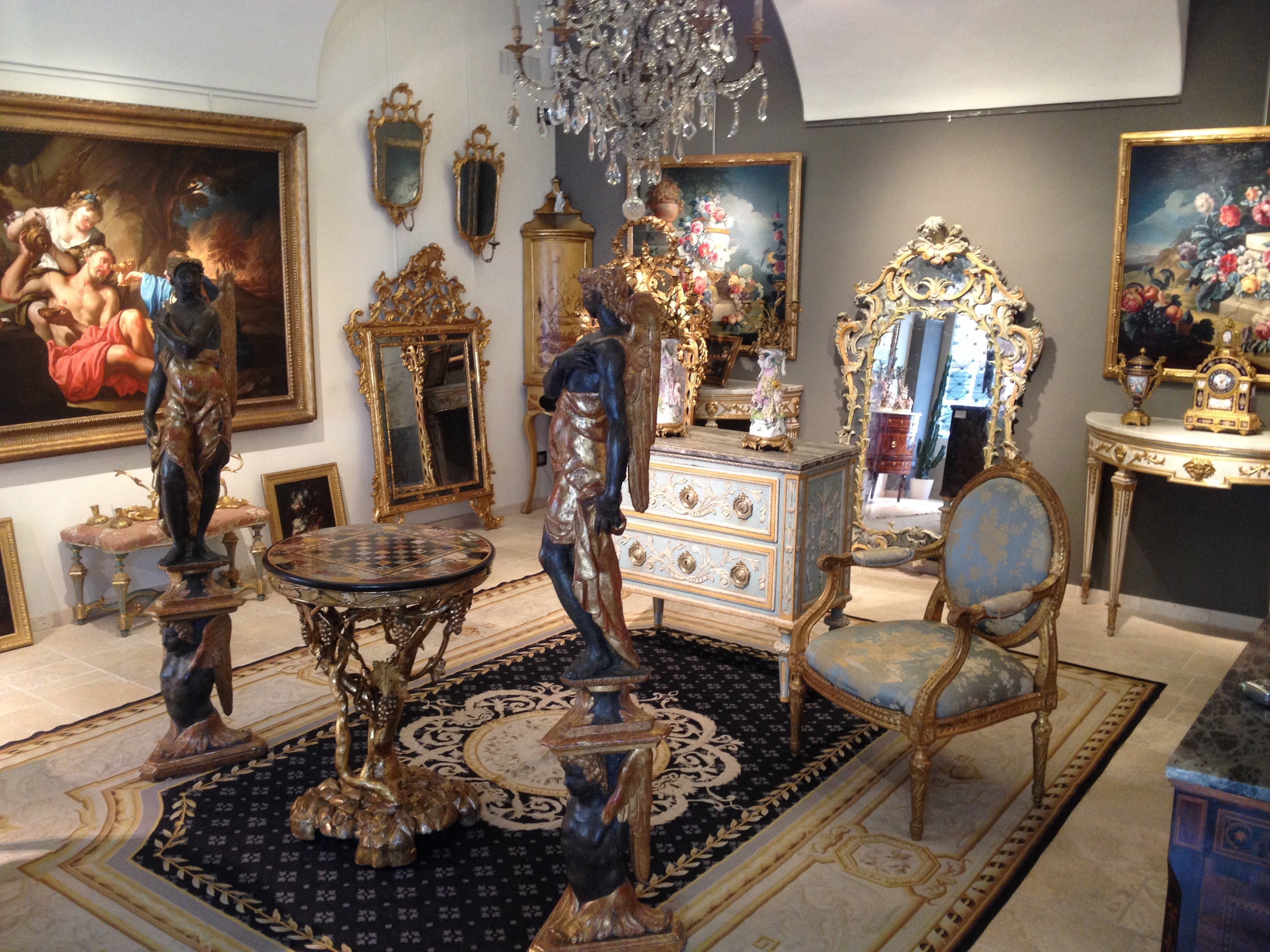
About the Seller
5.0
Platinum Seller
Premium sellers with a 4.7+ rating and 24-hour response times
Established in 1980
1stDibs seller since 2019
53 sales on 1stDibs
Typical response time: <1 hour
- ShippingRetrieving quote...Shipping from: Italy
- Return Policy
Authenticity Guarantee
In the unlikely event there’s an issue with an item’s authenticity, contact us within 1 year for a full refund. DetailsMoney-Back Guarantee
If your item is not as described, is damaged in transit, or does not arrive, contact us within 7 days for a full refund. Details24-Hour Cancellation
You have a 24-hour grace period in which to reconsider your purchase, with no questions asked.Vetted Professional Sellers
Our world-class sellers must adhere to strict standards for service and quality, maintaining the integrity of our listings.Price-Match Guarantee
If you find that a seller listed the same item for a lower price elsewhere, we’ll match it.Trusted Global Delivery
Our best-in-class carrier network provides specialized shipping options worldwide, including custom delivery.More From This Seller
View All18th Century, Italian Painting Depicting Landscape with Watermill and Characters
Located in IT
18th century, Italian painting depicting landscape with watermill and characters
Oil on canvas; Measurements: frame cm L 103.5 x H 127 x P 5; painting L 93 x H 117.5
The painting...
Category
Antique Mid-18th Century Italian Rococo Paintings
Materials
Canvas
18th Century, Italian painting Depicts Bambocciata by Giovanni Michele Graneri
Located in IT
Giovanni Michele Graneri (Italy, Turin 1708-1762)
Bambocciata (Farmers dancing in front of the inn)
The painting, made in oil on canvas, depicts a moment of celebration where some p...
Category
Antique Mid-18th Century Italian Baroque Paintings
Materials
Canvas
$20,476 Sale Price
32% Off
18th Century, Italian Painting Still Life by Giovanni Paolo Castelli Lo Spadino
Located in IT
Giovanni Paolo Castelli, known as "Lo Spadino" (Rome 1659 – around 1730)
Still Life with a Composition of Fruit
Dimensions: frame cm L 76.5 x H 61 x D 6.5. Canvas cm L 55.5 x H 40
Th...
Category
Antique Early 18th Century Italian Baroque Paintings
Materials
Canvas, Wood
18th Century, Italian Oil on Canvas Painting with Landscape with Ruins
Located in IT
18th century, Italian oil on canvas painting with landscape with ruins
Measures: only the canvas cm W 97.5 x H 108; with the frame cm W 103.5 x H 114 x D 5
The fine oil on canv...
Category
Antique 18th Century Italian Baroque Paintings
Materials
Canvas
18th Century, Pair of Italian Paintings, Landscapes with Ruins by Gaetano Ottani
Located in IT
Gaetano Ottani (1720 - 1724 / 1801)
Pair of paintings depicting landscapes with ruins and figures
Measurements: canvas cm W 82 x H 66; with frames cm W 98 x H 82 x d 6
The two valuable paintings, made in oil on canvas, depict landscapes with architectural whims animated by some figures. The architectural whim, an artistic genre that has made its way in Italian painting since the seventeenth century, is characterized by the representation of fantastic architectures or inventions of perspective type, sometimes combined with elements drawn freely from reality.
In the works we observe large arches, colonnades and friezes fallen into disrepair, placed in perspective in order to create a greater depth, are inhabited by spontaneous vegetation that partly covers the top. Around other architectural elements of classic taste, such as sarcophagi and vases, move and balance the composition. Greenery dyes the ground, which fades on the horizon into plains with some small and distant buildings, while some rocky mountains are lost far away, creating a scenic backdrop that emphasizes and amplifies the effect of the perspective escape line of buildings.
Some figures of gentlemen who entertain in speeches, accompanied by a dog, other travellers and characters from rural life enliven the composition.
It highlights a remarkable pictorial quality with which the artist traces the characters and the ruins and a bright and well-balanced color, played on delicate tones and in harmony with each other.
Stylistically the works are certainly attributable to the Italian painter Gaetano Ottani (Italy, Bologna, 1708 - Turin, 1801).
Gaetano Ottani was born in Bologna in 1708. Unfortunately, the artist still lacks a monographic study. The date of death by many still erroneously indicated in 1808 is instead 14 January 1801 when the artist was 92 years old. He was therefore born in 1708, and not in 1720-24 as many report (for the recording of the act of death to the Municipality of Turin, cf. Historical Archives of the Municipality of Turin, Rubrics of the Acts of Death, vol. 37: Thursday, January 15, 1801 "Gaetano Ottani - 92 - old age - S. Filippo" is preserved among the documents of the parish of San Filippo di Torino).
Ottani studied at the Accademia Clementina. He had a complex career as a set designer, as a painter and as a tenor, much appreciated in Italy. He devoted himself mainly to easel painting, and in particular to the genre of caprice, often with views of ruins and fantasy marinas full of details, night visions on colonnades. He first took as an example Pietro Paltronieri, the Mirandolese; to the maturation of the style, he had to concur the study of known artists in the journeys undertaken as an opera singer. He was very influenced by the great scenographer Ferdinando Galli Bibiena.
Tenor, and therefore in the system of the voices of the drama for music of the mid-eighteenth century predestined to the parts of ruler and parent, he always sang only in “opera seria”. Diego Tufarelli, impresario at S. Carlo in those years, had hired Ottani considering him the tenor...
Category
Antique Mid-18th Century European Baroque Paintings
Materials
Canvas, Giltwood
$20,476 Sale Price
32% Off
18th Century, Two Still Lifes with Flowers and Fruits by Italian Paintings
Located in IT
Piedmontese painter of the second half of the 18th century
Two "Still Lifes with composition of flowers, fruits and mushrooms"
Measurements: Frames: cm W 63 x H 74 x D 8.5
frames...
Category
Antique 18th Century Rococo Paintings
Materials
Canvas, Giltwood
You May Also Like
San Pietro by Giovanni Battista Piazzetta’s follower, Venice 18th Century
Located in Spinea, Veneto
San Pietro by Giovanni Battista Piazzetta’s follower – Venice XVIII century
The painting is a very-well executed replica of the famous original by Giovan...
Category
Antique 18th Century Italian Paintings
Materials
Canvas
Baroque Jesus Painting By Giovanni Battista Gaulli, 17th Century
By Giovanni Battista Gaulli
Located in Lisbon, PT
A painting, prior to 1678, from a famous fresco of the Triumph of the Name of Jesus from the Gesù Church in Rome, completed in 1684, attributed to the Old Master Painter Giovanni Bat...
Category
Antique 17th Century Italian Paintings
Materials
Canvas, Wood
Andrea Locatelli, Italian/Roman Landscape Painting with Figures, 18th Century
Located in CH
A Roman landscape oil on canvas painting with figures by Andrea Locatelli (Roma 1693-1741)
Locatelli was amongst the group of landscape painters in R...
Category
Antique Early 18th Century Italian Rococo Paintings
Materials
Canvas
LATE 18th CENTURY LANDSCAPE PAINTING WITH FIGURES
Located in Firenze, FI
Charming oil painting on wooden panel, elegantly framed in a carved and gilded wooden frame. The work depicts a landscape at sunset, with a city looming in the distance. In the foreg...
Category
Antique Late 18th Century Italian Paintings
Materials
Wood, Paint
Late 18th C. American Landscape Painting with Animals
Located in Los Angeles, CA
American landscape with animals, unsigned.
The measurements below are with the frame
without the frame the measurements are: 21.5" W x 17" H.
Category
Antique 1790s American Paintings
Materials
Paint
18th Century Lying Female Figure Painting by Giovanni Domenico Molinari
Located in Milan, IT
Giovanni Domenico Molinari (Caresana, 1721 - Turin, 1793)
Lying Female figure
Oil on canvas, cm 46 x. 31 - With frame, cm 56 x 42
The present painting is connected by style and treated subject, in this case a young girl lying in an idyllic landscape, to the production of small pictures of pastoral subject of the Piedmontese painter Giovanni Domenico Molinari (Caresana, 1721 - Turin, 1793).
Molinare was born in Caresana (Vercelli) on 19 July 1721 but after losing both his parents he moved to Turin. Here he became, from 1736, a pupil of the Academy of Drawing founded by the painter Claudio Francesco Beaumont (Turin, 4 July 1694 - Turin, 21 June 1766) where he remained as a pensioner until December 1755. Molinari was immediately engaged in the translation of the master’s sketches on cardboard used for the Regia manufacture of tapestries. His early success on the Turin art scene is confirmed by the fact that he joined the Compagnia di San Luca in 1756.
In 1751 he married Margherita Peiroleri, whose brothers Pietro (engraver) and Nicolò (painter) also attended the school. Remained widower count two other marriages first with Lucrezia Elisabetta Burzio and then in 1770 with Domenica Maria Ferrero.
On the death of the master in 1766 Molinari, considered by his contemporaries to be the most faithful interpreter of the master and for his elegant and Arcadian style, which clearly interprets the aesthetic taste of the court, was called to finish the works that remained unfinished, such as the altarpiece for the church of Santa Maria della Scala in Moncalieri depicting the Assumption venerated by Blessed Bernard of Baden and Saint Anthony. Molinari was also well praised by critics and Abbot Lanzi highlighted the quality of the production of historical and mythological subject for the rigorous post-marattesco classicism.
In Turin he worked for Vittorio Amedeo III of Savoy as a portrait painter, executing for him eleven canvases (between 1774 and 1775), but, since 1745, he also supplied tapestry cartoons to the local Fabbrica, of which, in 1766, he became director.
The production of paintings of sacred subjects is also lively, especially used in the decoration of the churches of the capital as the Assumption for the Hotel of Virtue and San Pietro Regalado and San Benedetto il Moro for Santa Maria degli Angeli ( Torino) He also painted tempera and oil cartoons for the same church, on the occasion of the beatification of Pacifico da San Severino (1787) and, for that of San Francesco di Paola, when Gaspare de Bono...
Category
Antique 18th Century Italian Paintings
Materials
Canvas
